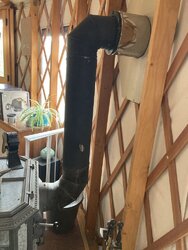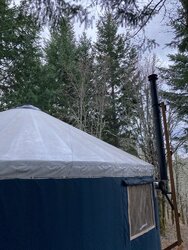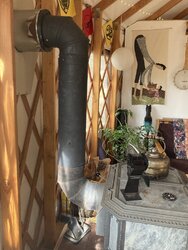Hello all,
I live in a 30' diameter canvas yurt with a Woodstock Fireview as our sole heat source. It's an awesome stove that generally works great... after I clean the chimney. However, I seem to be getting creosote build-up in the chimney at a pretty fast rate. This is my first time living with a woodstove so not really sure what's normal, but I cleaned the chimney in mid-December, for example, and I think it's more than needs it again already after regular-but-not-super-heavy use for that month and a half. We were gone most of that time and had a yurtsitter who I suspect might not have been running the stove quite right, as it smelled pretty smoky inside when we got home, But apart from any operater error issues, I'm wondering if there are some tweaks I could make to the chimney system that would help. I get a little nervous when it smells like smoke inside that I'm slowly poisoning my family!
A month or two after cleaning the chimney I start to get increasing problems with smoke coming into the yurt when reloading the stove or starting a fire. The last couple days have been super windy and that seems to have increased the smoking issues. Apart from the general hassle of cleaning the chimney, it is extra annoying in a yurt because the structure doesn't hold heat very well - in winter by the time the stove is cool enough to clean, the yurt is freezing inside! We pretty much have the stove going non-stop from late fall to early spring. So anything I can do to extend the cleaning interval would be wonderful.
I'll attach a couple pictures, but basically, stovepipe comes out the back of the stove, 90's up, runs vertical a few feet, 90s out the wall into a T and then runs up 10 feet to cap. The two things I'm suspecting might be issues:
- Is the 10' main stack (plus the 3' of vertical single wall inside) enough height, given the two 90s and T in the system? If not, how much should I extend it?
- My interior pipes are connected a little off, such that the joints aren't totally tight since the angles aren't perfect 90s (this also causes the part of the 90 that connects to the stove to be angled slightly downhill away from the stove, and I have noticed some sooty discoloration on the outside of that 90). Wondering if I should just put furnace cement in the joints each time I put them back together after cleaning? Or worth it to reconfigure the set-up so that the angles are more perfect 90s?
My guess is that I just need to add more height to the chimney, but since that double walled ain't cheap, I thought I'd get some opinions before I try that. Any thoughts on the above, or anything else I might be missing would be greatly appreciated!
BTW, I am using well-seasoned dry wood, mostly doug fir from the property, and am confident that I'm operating the stove and catalytic combustor correctly.
Cheers,
Scott



I live in a 30' diameter canvas yurt with a Woodstock Fireview as our sole heat source. It's an awesome stove that generally works great... after I clean the chimney. However, I seem to be getting creosote build-up in the chimney at a pretty fast rate. This is my first time living with a woodstove so not really sure what's normal, but I cleaned the chimney in mid-December, for example, and I think it's more than needs it again already after regular-but-not-super-heavy use for that month and a half. We were gone most of that time and had a yurtsitter who I suspect might not have been running the stove quite right, as it smelled pretty smoky inside when we got home, But apart from any operater error issues, I'm wondering if there are some tweaks I could make to the chimney system that would help. I get a little nervous when it smells like smoke inside that I'm slowly poisoning my family!
A month or two after cleaning the chimney I start to get increasing problems with smoke coming into the yurt when reloading the stove or starting a fire. The last couple days have been super windy and that seems to have increased the smoking issues. Apart from the general hassle of cleaning the chimney, it is extra annoying in a yurt because the structure doesn't hold heat very well - in winter by the time the stove is cool enough to clean, the yurt is freezing inside! We pretty much have the stove going non-stop from late fall to early spring. So anything I can do to extend the cleaning interval would be wonderful.
I'll attach a couple pictures, but basically, stovepipe comes out the back of the stove, 90's up, runs vertical a few feet, 90s out the wall into a T and then runs up 10 feet to cap. The two things I'm suspecting might be issues:
- Is the 10' main stack (plus the 3' of vertical single wall inside) enough height, given the two 90s and T in the system? If not, how much should I extend it?
- My interior pipes are connected a little off, such that the joints aren't totally tight since the angles aren't perfect 90s (this also causes the part of the 90 that connects to the stove to be angled slightly downhill away from the stove, and I have noticed some sooty discoloration on the outside of that 90). Wondering if I should just put furnace cement in the joints each time I put them back together after cleaning? Or worth it to reconfigure the set-up so that the angles are more perfect 90s?
My guess is that I just need to add more height to the chimney, but since that double walled ain't cheap, I thought I'd get some opinions before I try that. Any thoughts on the above, or anything else I might be missing would be greatly appreciated!
BTW, I am using well-seasoned dry wood, mostly doug fir from the property, and am confident that I'm operating the stove and catalytic combustor correctly.
Cheers,
Scott




